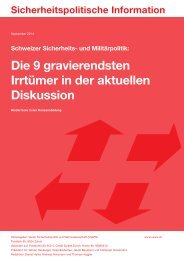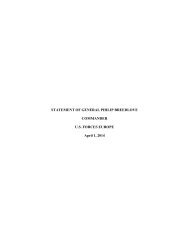FULLTEXT01
FULLTEXT01
FULLTEXT01
You also want an ePaper? Increase the reach of your titles
YUMPU automatically turns print PDFs into web optimized ePapers that Google loves.
TACTICAL THOUGHT<br />
2014 September 29 th<br />
He defines “Insurgency” as; “to cover the use of armed force by a selection of the<br />
people against the government for the purposes mentioned above”, here referring to the<br />
explanation of subversion. 339<br />
The area of Peacekeeping, understood as “how to prevent by non-warlike methods, one<br />
group of people from fighting another group of people” is also covered by Kitson, thus<br />
already in 1971, covering the whole spectrum of emergencies that might have to be<br />
handled by, or supported by military forces. 340 This perspective is uncommon to be<br />
found in most analyses of Irregular Warfare during the Cold War. Still today, with the<br />
expanding writing on the subject, Peacekeeping is seldom included. Kitson argues for<br />
some main differences between Irregular and Regular Warfare. The first he claims are<br />
the areas of subversion and Insurgency; both are forms of civil conflicts. The second is<br />
the claim that the use of “persuasion is the main method of gaining support” (of the<br />
people), sometimes backed up by uses of force and this in contrast to regular war where<br />
the opposite is the rule, that is mainly force, sometimes backed up by persuasion. 341<br />
With the terms subversion and insurgency, Kitson covers all influence and violence<br />
activities directed by people (often needing support from the outside) up to the conduct<br />
of Regular War with these two terms. He also includes civil war as a result of an<br />
insurgency in some ways. 342 He refers to Roger Trinquier’s term “Modern Warfare” as<br />
a lumping together of subversion and insurgency, as being an interlocking system of<br />
actions, political, economic, psychological and military that aim at the overthrowing of<br />
established authority in a country. 343 Regarding attitudes for this kind of operation by<br />
the army and military organizations in the western countries, Kitson discusses this in his<br />
last chapter of the book. 344 Attitude problems will in turn be the subject for fighting<br />
morale and thus a question regarding fighting power for military units countering<br />
subversion and insurgencies.<br />
Result and conclusions<br />
The descriptions are of both an explanatory and umbrella character. The potential of<br />
explaining content covers aspects of strategy but focus on operational art and tactics.<br />
Fighting power factors are covered such as physical factors but the focus is on<br />
conceptual factors. Moral factors are implicitly dealt with. The descriptions cover<br />
characteristics of subversion and insurgencies and also regarding the need for personal<br />
characteristics, dealing with “Low Intensity Operations”. Attitude aspects are included<br />
and participating actors are described both from the attacker and defender position. The<br />
description leans primarily on a military focus of the phenomena, such as handling such<br />
operations. The description does not demand an understanding of sub-terms as Kitson<br />
explains them as they occur. The descriptions are clear and have good potentiality of<br />
being easily understood.<br />
339 Kitson, Low Intensity Operations, Subversion, Insurgency, and Peacekeeping (1971), p. 3.<br />
340 Ibid. p. 4.<br />
341 Ibid. pp. 4-5.<br />
342 Ibid. p. 4.<br />
343 Ibid. p. 5. Kitson refers to Roger Trinquir, Modern Warfare: A French View on Counterinsurgency<br />
(Westport, CT: Preager, 1964, reprinted 2006), p. 6.<br />
344 Ibid. pp. 198-201.<br />
40





